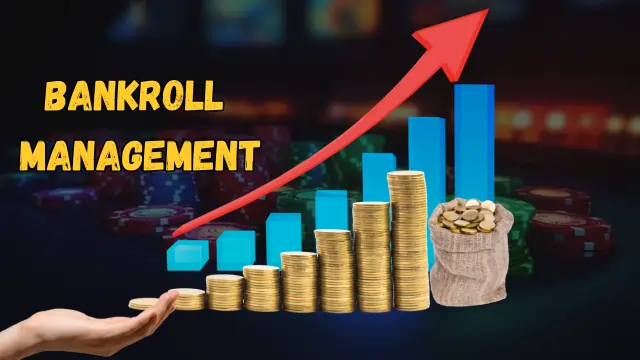🎲 What is Bankroll Management?
Bankroll Management: Ever had a fun casino night turn into regret because your wallet emptied too fast? You’re not alone! Smart gamblers use a trick called bankroll management—a strategy that helps control how much money you use for gambling so you don’t end up broke after one bad streak.
💡 Think of bankroll management as your personal safety net. It:
- Protects you from sudden big losses
- Helps you stay within your limits
- Teaches you discipline and patience
- Let you enjoy the thrill of gambling without financial stress
- Increases your odds of staying in the game long-term
Whether you’re playing online slots, betting on sports, or enjoying poker nights, learning how to manage your bankroll is one of the smartest moves you can make.

💸 Step 1: Set a Gambling Budget You Can Afford to Lose
The golden rule: only gamble with money you’re 100% okay losing. If it’s rent money or savings for groceries, don’t touch it. Gambling should be fun, not a financial risk.
📝 How to create your bankroll:
- Look at your monthly budget. What’s left after essentials?
- Decide on a fixed amount just for gambling fun (e.g., ₱500 a week)
- Separate it from your main wallet using another e-wallet or a prepaid card
- Never borrow money or use credit cards for gambling
- Don’t try to “win back” money you’ve already lost—it usually leads to more losses
🎯 Real-life Tip: Treat your gambling money like money for going to the movies or buying snacks. Once it’s gone, the fun is over for the day!
📏 Step 2: Pick the Right Bet Size for You
Your betting unit is the amount you wager per bet. Choosing the right size helps keep your money from vanishing too fast and gives you more chances to win.
📊 Here’s a simple chart to follow:
| Risk Style | % of Bankroll | Ex. (₱1,000 Bankroll) | Sessions You Can Play |
| Conservative | 1–2% | ₱10–₱20 per bet | 50–100+ bets |
| Moderate | 3% | ₱30 per bet | 30–35 bets |
| Aggressive | 4–5% | ₱40–₱50 per bet | 20–25 bets |
🎰 Why this matters: If you blow your bankroll in 5 bets, you’re done. But 50 smart bets? That gives you time to spot patterns, enjoy the game, and recover from losses.
🛑 Step 3: Set Stop-Loss Limits (Know When to Walk Away)
A stop-loss limit is how much you’re willing to lose before calling it quits. Without one, you’ll be tempted to keep chasing your losses until your bankroll hits zero.
📉 Common stop-loss strategies:
- Per session: Set a limit of 15–20% of your bankroll.
Example: If you start with ₱500, stop playing once you lose ₱75–₱100. - Daily limit: Set a cap on how much you’re willing to lose per day—ideally no more than 30% of your bankroll.
- Weekly or monthly limit: Keep your losses in check across all sessions, not just one.
💥 Pro Tip: Set an alarm or reminder to check your balance every 30 minutes. It’s easy to get carried away!
🤑 Step 4: Set Win Goals to Protect Your Profits
Just like stop-loss limits help you avoid big losses, win goals help you keep your winnings. It’s tempting to keep playing when you’re ahead, but that’s how many players give it all back.
🏆 Set these goals:
- Session target: Stop after winning 50% of your session bankroll.
- Profit plan: If you double your bankroll, withdraw your starting amount and continue playing with only the profits.
- Cash-out tiers:
- Win ₱300 from a ₱200 bankroll? Take ₱200 back, and use ₱100 for more play.
- Win another ₱100? Consider cashing out ₱50 and playing with the rest.
💸 Real Talk: “I’ll stop after just one more win” is a dangerous mindset. Have a cash-out plan and stick to it!

📊 Step 5: Track Your Gambling Like a Pro
Tracking helps you stay accountable and see patterns in your play. Many successful players—especially poker and sports bettors—track every move.
🧾 What to include in your log:
- Game type and platform
- Date and time played
- Amount wagered and won/lost
- Duration of session
- Emotional state (tilted, confident, bored, etc.)
- What worked and what didn’t
📈 Over time, this log will show you where you win most—and where you might be wasting money.
🧠 Step 6: Adjust Bankroll Based on the Game You Play
Not all games are created equal! Skill-based games like poker allow more flexibility, while luck-based games like slots require strict limits.
🎴 Poker:
- Keep 20–30 full buy-ins for cash games
- For tournaments, 50–100 buy-ins help cover variance
⚽ Sports Betting:
- Stick to flat betting (1–3% of bankroll per bet)
- Avoid parlays unless it’s with very small amounts
🎰 Slots:
- Choose machines based on your bankroll (low volatility = longer playtime)
- Break your bankroll into smaller session funds
- Walk away after a big win
🎲 Casino Table Games:
- Blackjack: Keep 40–50x your average bet
- Roulette: Keep 50–60x your base unit
- Craps: Avoid risky combo bets—stick to pass/don’t pass
🕹️ Tip: The higher the variance (risk of swings), the more bankroll you need.
🧘 Step 7: Control Your Emotions While Gambling
When gambling, your biggest enemy isn’t always the house—it’s your own emotions. Emotional betting can ruin even the best strategy. When you let your feelings control your decisions, you’re more likely to chase losses, make larger bets than planned, and ignore your stop-loss or win goals.
To stay calm and centered, take regular breaks—every 30 to 60 minutes is ideal. If you find yourself on a losing streak of 3–5 rounds, step away and regroup. Celebrate small wins, but don’t let success cloud your judgment or lead to overconfidence. Even when you’re “feeling lucky,” stick to your original plan. Discipline helps you enjoy the game longer and keeps your bankroll alive.
⚠️ Common Mistakes That Kill Your Bankroll Management
Avoiding these common errors can already put you ahead of 90% of other players. One big mistake is betting bigger after every win. While it might seem like a way to “ride the streak,” it often ends with big losses. Stick to your set unit size, no matter how hot you feel.
Don’t forget to set stop-loss limits before you even begin playing. Write them down, and be strict with yourself. Crossing the line leads to impulse betting. Also, track your sessions. Use a spreadsheet or an app—anything that helps you stay aware of how much you’re spending and winning.
Finally, playing too long without taking a break leads to fatigue and poor decisions. Set a timer, and force yourself to step away for 10 minutes. A clear mind is your best tool in gambling.
💼 Bonus Tip: Grow Your Bankroll Management Like a Pro
Think of your bankroll as capital for your gambling “business.” If you want it to grow, you need a plan—just like an investor. Reinvest a portion of your winnings to keep your balance growing, but also withdraw part (around 30%) every time you double your bankroll to secure your profit.
Manage risk by splitting your bankroll:
- 📊 60% for low-risk games (like blackjack or even-money roulette)
- 🎲 30% for medium-risk games (such as video poker or crash games)
- 🎰 10% for high-risk bets (like progressive slots or jackpots)
At the end of each week or month, review your results. What worked? What didn’t? Adjust your strategy like a boss. Smart players don’t just play—they analyze and adapt.
🧠 Final Word: It’s not just about winning big—it’s about playing smart, enjoying the game, and staying in control. 🎰 Ready to play smarter? Visit https://tropagaming.com/ for more expert strategies, honest casino reviews, and amazing bonus updates! 🚀
Frequently Asked Questions
1. What is bankroll management in gambling?
Bankroll management means setting a fixed budget for gambling and using strategies to make it last. It helps you avoid losing more than you can afford and makes your gaming experience more enjoyable and less stressful.
2. How much should I include in my gambling bankroll?
Only use money you can afford to lose—never dip into rent, bills, or savings. A good rule of thumb is to start with an amount that won’t affect your daily life, like ₱500–₱2,000, depending on your income and risk comfort.
3. How do I know what my bet size should be?
Use the “unit size” method: bet 1–5% of your total bankroll per game or round. For example, with a ₱1,000 bankroll, you should only bet ₱10–₱50 per round to avoid going broke too fast.
4. What is a stop-loss limit?
A stop-loss is the maximum amount you’re willing to lose in a session. Set this amount before you play. Once you hit it—stop playing, no matter what. It protects you from emotional decisions and major losses.
5. Can I increase my bet size after winning?
It’s tempting, but risky. Many players go broke by chasing hot streaks. Stick to your set unit size. If you win a lot and want to bet bigger, recalculate your unit size based on your new bankroll—but only after a break and some review.
